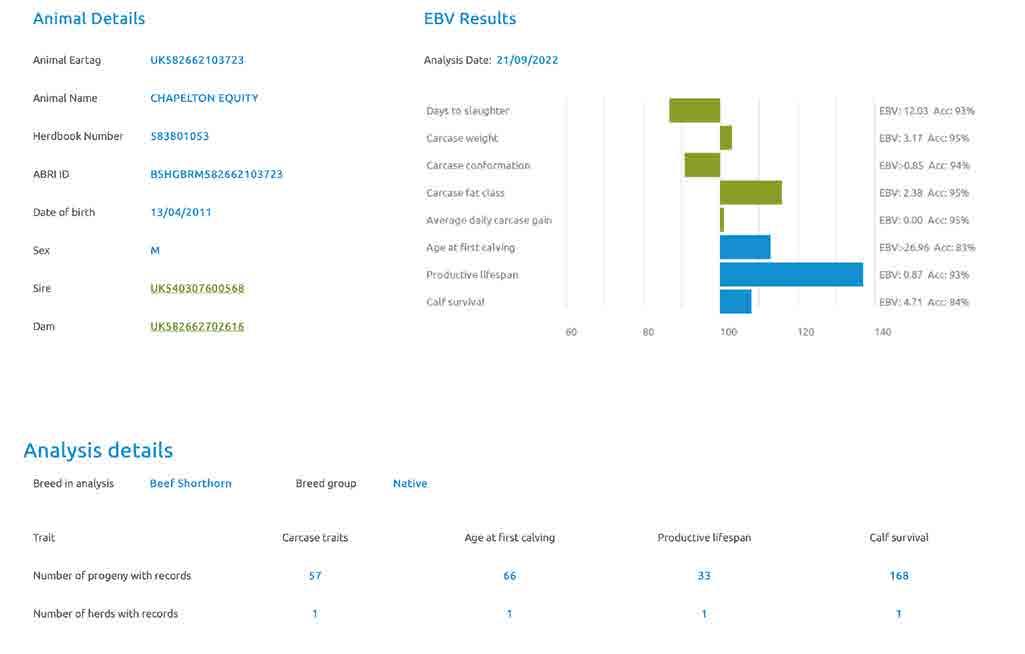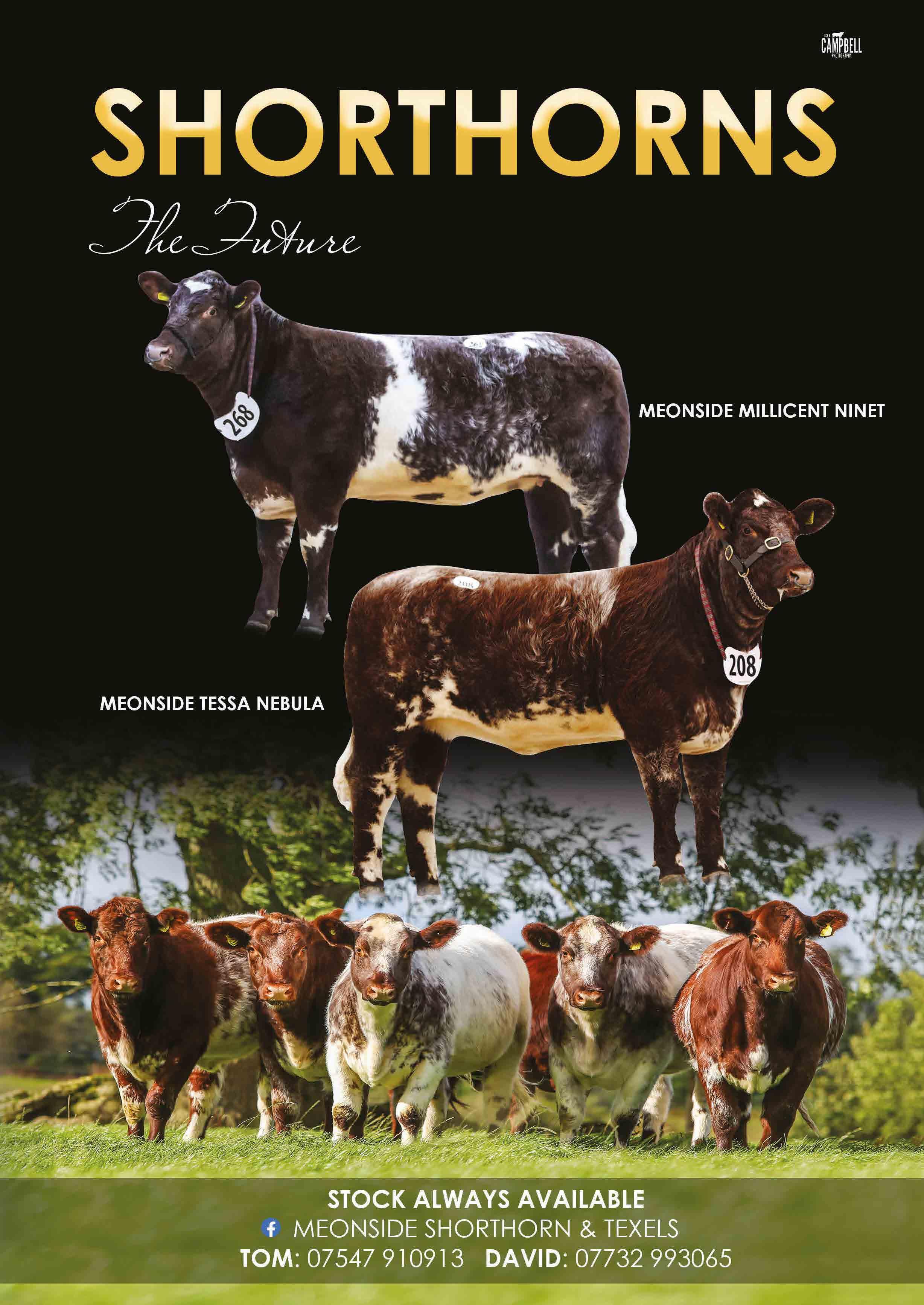
7 minute read
EBVs for maternal traits
New EBVs to improve maternal efficiency and productivity
With the farming sector facing ongoing uncertainties including changes to basic payments and increased pressure to reduce carbon emissions, many suckler farmers are investigating ways to improve the efficiency of their cattle enterprises. Could AHDB’s new maternal breed evaluations be the answer? Dr Alex Brown, AHDB’s senior beef breeding and genetics manager, explains more.
Advertisement
In the past, much of the interest in improving efficiencies has been focused on terminal traits including growth rate and carcass quality. However, with 70% of the cost from suckler beef production, plus emission levels both originating from the suckler cow, farmers are starting to turn their attention to maternal efficiency.
For the past year, AHDB has been working to promote the production of heifers that are efficient, profitable and fit for the future, under the Maternal Matters campaign. Alongside appropriate management and nutrition, choosing the right genetics for breeding heifer replacements is a key long-term investment, as the benefits are cumulative and permanent.
In 2018, AHDB launched the National Beef Evaluations providing estimated breeding values (EBVs) for five commercial carcass traits in beef cattle, using national data from processors, breed societies and the British Cattle Movement Service (BCMS). Thanks to further research and analysis in conjunction with Scotland’s Rural College, it has been possible to leverage further value from routinely recorded BCMS data and release three new maternal EBVs through the National Beef Evaluation database. These are:
1. Age at first calving 2. Productive lifespan 3. Calf survival
Understanding the new maternal trait EBVs
This set of EBVs is derived directly from commercial data and should, therefore, be of high interest to commercial producers as well as the pedigree sector. So, as well as being useful when making your own breeding decisions, these EBVs could also be used as a marketing tool when selling stock bulls.


These new EBVs provide an opportunity to have a cumulative and permanent impact on suckler herd performance by improving your herd genetics and they link tightly to key maternal performance indicators (KPIs).
Age at first calving
Definition: An EBV predicting the age at which a heifer has her first calf. Selecting for this EBV will produce animals more likely to hold service at a younger age. Calculated from: Birth and calving dates from BCMS Unit of measurement: Days Interpretation: Chapelton Equity has an age at first calving EBV of -26.96 days. On average, he will produce progeny which calve 13.5 days earlier than progeny from a bull with an age at first calving EBV of 0. KPI: Age at first calving.
Choosing the right genetics for breeding replacement heifers is key to long-term investment and herd development.
Productive lifespan
Definition: An EBV predicting how long females will stay in the breeding herd. Calculated from: Birth, calving and death dates from BCMS Unit of measurement: Parities (number of calvings) Interpretation: Chapelton Equity has a productive lifespan EBV of 0.87. Based on a herd of 100 cows, a herd sired by Chapelton Equitywill have an average of 44 more calvings between them before being replaced, than a herd sired by a bull with a productive lifespan EBV of 0. KPI: Herd replacement rate
Calf survival
Definition: An EBV predicting the likelihood of tagged calves surviving to 10 months of age. Calculated from: Birth and death dates from BCMS Unit of measurement: % Interpretation: Chapelton Equityhas a calf survival EBV of 4.71%. On average, he will produce progeny which are 2.36%more likely to survive to 10 months of age than progeny from a bull with a calf survival EBV of 0. KPI: Calves weaned, as a % of females put to the bull.
Remember: The EBV relates to the bull’s genetic merit. He contributes 50% of his genetics to his progeny, therefore, the average progeny performance is 50% of the EBV value.
What this means for your business
There is a high variation for these three traits in all breeds and as usual the variation within breeds is higher than the variation seen across breeds. The heritability of these new maternal EBVs ranges from 4% (calf survival), to 11% (age at first calving). Although the genetic influence on these traits is fairly low, there is still good progress to be made using genetic improvement because these traits have such a high economic value.
All the EBVs available on the National Beef Evaluations database are available to compare across breeds, which is not possible via breed society evaluations. However, we recommend looking at our EBVs alongside Breedplan’s pedigree evaluation, as the two sets of information are complementary to each other.
How to access the data
The new EBVs are hosted alongside EBVs for carcass traits on the AHDB National Beef Evaluation’s website at www.ahdbbeef.egenes. co.uk and you can search by pedigree name or ear tag number. You can also access them directly from the animal record page on Breedplan.
Developments have also been made to the National Beef Evaluation website, including details of trait definitions, release dates and both across and within-breed benchmarking tables, as well as a handy reference page listing the pedigree evaluation service providers for each beef breed. Further improvements in the pipeline include a comprehensive FAQ page and an EBV search function.
Driving the data forward through sire recording
The production of these EBVs relies on sire details being recorded on passports to be able to identify genetic links between bulls and recorded progeny. In the latest genetic evaluation (August 2022), there were more than 3m records that could not be used in the National Beef Evaluation analysis because the sire was not recorded in BCMS, so genetic links could not be made.
AHDB continues to urge farmers to make sure they record known sires when registering animals with BCMS as this is the best way to improve the range and accuracy of these EBVs. As well as continuing to record all known sires for your own herd, please encourage buyers of stock bulls to do the same. Increasing the level of sire recording will allow us to identify genetic links between cattle and improve the accuracy of the results.
AHDB Beef & Lamb has produced a Suckler Breeding Plan to help farmers record sires used on groups of animals if you don’t have computer software. This can be found at https://ahdb.org. uk/knowledge-library/suckler-breeding-plan-forbetter-returns
Interested in improving the efficiency of your breeding herd? Find out more about AHDB’s Maternal Matters campaign at https://ahdb.org. uk/knowledge-library/maternal-matters
An update on the carcass trait evaluations
The National Beef Evaluation for commercial carcass traits was first published in November 2018. Abattoir data flows into the database on a weekly basis from processors, with evaluations carried out three times a year, in April, August, and December.
Since the first evaluation was released in 2018, the number of pedigree Beef Shorthorn cattle with carcass EBVs has risen by 42%, meaning there are now EBVs published online for more than 70,000 pedigree registered cattle. Once commercial cattle are considered, the number of animals with published EBVs rises to almost 140,000.
Breed benchmark tables are now produced for the National Beef Evaluation, which allow you to assess the genetic merit of your cattle on both a within and an across breed basis. The table below is an extract from the within-breed benchmark and substantial differences can be seen in genetic merit between the bottom 5% and top 5% of cattle for each trait. For example, on average, progeny from a top 5% bull for age at slaughter will finish to a constant carcass weight almost 14 days earlier than progeny from a bottom 5% bull. Because of the level of variation in the population and the high heritability of the carcass traits (~40%), using these EBVs in your breeding decisions should result in good genetic progress for carcass traits.
As always, the top performing bull for a particular trait or index isn’t the best bull for every system.
Paying attention to maternal efficiency is key, with 70% of costs in suckler production originating from the suckler cow, says Alex Brown.

When using EBVs to assist your breeding decisions, make sure you have identified your target market and what your cattle need to achieve to meet those requirements, so that you can identify which traits you need to improve. More information on bull selection, breeding and genetics can be found in AHDB’s choosing bulls for better returns manual at https://ahdb.org.uk/ Contents/Item/Display/22686
Beef Shorthorn carcass traits benchmark
Trait Days to slaughter Carcass weight Carcass conformation Carcass fat class Average daily carcass gain Bottom 5% Bottom 25% Average Top 25% Top 5% 13.81 -0.75 0.14 -5.46 -13.52
-10.51 -1.92 -2.12 -2.87 -0.98 -0.88 -0.45 -0.32 -0.01 -0.77 0.33 0.86 15.42 -0.27 -0.11
-0.02 -0.01 0 0.02 0.03
Total Beef Shorthorn animals with EBVs Number of phenotypes contributing Pedigree Beef Shorthorn animals with EBVs Number of phenotypes contributing 2018 evaluation August 2022 evaluation Percentage increase
96,328 139,146 44%
51,493
50,086 76,560
70,971 49%
42%
21,740 31,994 47%












